
Original Link: https://www.anandtech.com/show/596
 Voodoo5
5500 PCI
Voodoo5
5500 PCI
With the current trend in computers as fast paced as it is, frustration is a common feeling. This frustration is a feeling not only felt by the power user who spent big bucks building the system of her dreams only to find it antiquated in less than 6 months, but it is a feeling shared across the board. Be it a casual user who purchased an OEM system only to find that in a short period of time the system was no longer sufficient for his needs or a parent who got a computer only to find that it would not play the games that were birthday presents, "getting burned", as it is commonly referred too, is a pain closely associated with computers.
This pain is not only a result of OEM systems that seem to "favor" that particular OEM's products but also with the lightening fast speed at which technology changes. Systems bought as recently as the last month could suffer from these problems, be it from older CPU socket styles such as Super Socket 7 or a lack of available PCI slots for use in upgrades. Although CPU slot incompatibles seem to wreak the most havoc on older systems, innovations such as a slocket or a voltage regulator were produced with these problems in mind, making the path of upgrade easier than before. One problem that remains for many users, however, is 3D acceleration.
Ever since the 440LX introduced 1997, Intel has included an AGP port for use with current graphics cards. While this may seem like eons in the computer world and it is true that many older chipset users have long since upgraded, Intel has offered AGP slot-less motherboards targeted at OEM markets. With the introduction of the i810 motherboard, Intel produced a very attractive solution to OEM system builders: include an integrated "AGP" card and leave out the AGP slot altogether. This made for not only lower motherboard manufacturing costs, it also resulted in lower system prices as a pricey video card was no longer necessary. This perfect plan for OEM system builders turned out to be the perfect nightmare for computer shoppers.
Although the integrated i752 derived video on the i810 proved to be an attractive solution for 2D use, ever since its introduction the processor's 3D image capabilities have lagged behind the competition's. Time has only widened this gap, making the i810 almost useless in newer 3D accelerated software titles. The easy solution would be to upgrade, replacing the aging budget i752 integrated video solution with a newer video card. As simple as this sounds, it turned out to be a daunting task for i810 owners. With no AGP port, i810 owners looking for a video card upgrade were left with not only a poor product selection but also an old one. Sure, the newest GeForce and GeForce 2 chips are able to be used in a PCI video card, however due to what manufacturers believe is low demand, it seems that all plans for a GeForce based PCI solution have been scrapped. In fact, the most powerful video card that was made for use in a PCI slot was the TNT-2, but even PCI versions of these cards are extremely difficult to find. This left users with only two viable options that were actually obtainable: the TNT and the Voodoo3 3000.
There is no question that both cards are aged, at best, but hey, almost anything is better than the integrated i810 video solution. The Voodoo3 3000 cards proved to be the lesser of the two evils for many users, making it the card of choice of quite a few i810 owners looking to play games. These card sales always proved to be a noticeable part of 3dfx's retail sales and many suspected that their newest offering, the Voodoo5 5500, would replace its brother as the card of choice for not only i810 users but anyone forced to use a PCI graphics card on today's latest games. The PCI Voodoo5 5500 is finally here, a short time after the AGP version arrived in stores. Will the card live up to 3dfx's history of providing a high end card for PCI systems? Let's take a look.
Luckily for all PCI card shoppers out there, the Voodoo5 5500 PCI is identical to its AGP counterpart with exception to the interface. A few weeks ago we took a very extensive look at the retail version of the 5500, a review which may be found here. In an effort to recap some of what the Voodoo5 5500 is made of, below are a few sections that summarize our results.
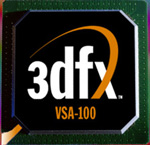 VSA-100
VSA-100
Each VSA-100 chip is based on a an "enhanced" .25 micron architecture with 15 million transistors on each chip. The SLI linking is a bit different than the older multicard SLI solutions offered by 3dfx in the past. The Voodoo5 5500 links its two processors using a 30-bit digital interface between the chips, providing for faster transfers and less degradation than found in the previous analog SLI solution. The chip adds support for 32-bit rendering, 32-bit textures, a 32/24-bit Z&W, and an 9-bit stencil buffer, providing for many improvements over the Voodoo3 chip. Each chip is able to process two pixels per clock.
The Card
Looking almost identical to the Voodoo5 5500 AGP, even the layout and design of the cards are nearly identical. The card features two of the VSA-100 chips, linked together in the previously mentioned SLI fashion. Physically the card has 64MB of memory, however all this memory is not available for each processor since textures must be duplicated for each of the 32MB of memory dedicated to each VSA-100 chip. The shared frame buffer memory means that the Voodoo5 5500 effectively has more than 32MB of memory to work with, but less than 64MB. The memory on our sample card was MT SDR 6ns memory, very similar to the Toshiba memory found on our sample AGP 5500. The two VSA-100 chips provide the 5500 with a fill rate of 667 megapixels per second in signal textured games and 333 megapixels per second in dual textured games. The fan, heatsink, and power connector remain unchanged.
AGP?
Perhaps one of the most interesting aspects of the Voodoo5 5500 AGP is, well, its lack of AGP. Take a look what we said in our Voodoo5 5500 review.
The chip is an AGP 4X part, with support for AGP 2X, AGP 1X and PCI operating modes. In spite of this the VSA-100 does not support AGP texturing. 3dfx still feels that AGP texturing is not truly beneficial and thus there is no reason to pursue support for it with their products.
What does this mean? Essentially it means that the Voodoo5 5500 AGP really is not a true AGP card after all. Sure, it operates at 66 MHz, but it does not take advantage of the biggest AGP feature: AGP texturing. Without the AGP texturing, running the Voodoo5 5500 in an AGP slot is like running it in an overclocked PCI slot, as the only difference is the speed at which information travels to and from the card, 33 MHz for the PCI version and 66 MHz for the AGP version. This means that the card is basically running in a 66 MHz PCI slot when in an AGP slot. In a bit we will take a look at the benchmarks and see how much of a difference this 33 MHz makes in game play.
FSAA
Both our Voodoo5 5500 review and our FSAA & Image Quality Comparison took a look at the FSAA quality of the Voodoo5 5500. To recap, here is a section from our FSAA & Image Quality Comparison.
3dfx definitely has the best 2 sample FSAA setting out of the bunch, although we were unsuccessful with tweaking the LOD bias settings when enabling 2 sample FSAA (other artifacts would pop up), the setting still seems to offer the best overall result in terms of image quality and performance.
The VSA-100's T-buffer seems to do the trick when it comes to FSAA, not only making the PCI Voodoo5 5500 the first PCI card to support FSAA but also one of the better AGP ones when it comes to support of it.
The Drivers
Taken from our Voodoo5 5500 review:
When we first previewed a preproduction Voodoo5 5500, we proclaimed that:
This is where the biggest performance improvement will lie, in the drivers. It is quite obvious that the drivers we were provided with weren’t optimized for performance across the board, since the performance of the Voodoo5 at lower resolutions such as 640 x 480 was sub-par.
We have definitely seen a slight improvement with the final drivers, the improvement is not as great as we had expected or hoped for. Overall we saw about 1-3 fps increase at most resolutions in Quake 3 and Unreal Tournament - less than 5% - and that can be partially attributed to final silicon. We did occasionally see drops in performance, but this was mainly at lower resolutions where it's not even noticeable.
We'd also like to address the much publicized "correct method" to install the Voodoo5 drivers that claim to increase performance up to three times. It was originally posted on 3dfxgamers.com's messageboards and discussed quite a bit in the AnandTech Forums as well. The problem appears when the card is identified as a "3dfx Voodoo Series," usually due to a previous 3dfx adapter in the system that was not uninstalled properly. If you did properly uninstall your old 3dfx card, or you never had one, this isn't an issue. When we originally tested the Voodoo5 for our preview, we used a cleanly formatted hard drive as we always do in our testing, so those performance numbers were not affected by this problem with the 3dfx installer. Needless to say, we've done the same thing in this final review.
There's also been some talk of refresh rates having a significant impact on performance. As with most recent cards we've tested, this is not the result that we have found in our testing. All our gaming benchmarks are performed at 60Hz with v-sync disabled.
Other than that, 3dfx tools remains relatively unchanged from the prerelease version. In order to obtain WHQL (Windows Hardware Quality Labs) certification, Microsoft does not allow vendors to include overclocking utilities or the ability to disable vsync. 3dfx's solution? Include a link in the drivers to download their overclocking utility that also adds check boxes to disable vsync. This way, 3dfx gets their WHQL certification to keep OEM's happy, while end-users get their tweaking utilities - that way everybody ends up happy. Kudos for 3dfx here for not requiring registry hacks or 3rd party utilities.
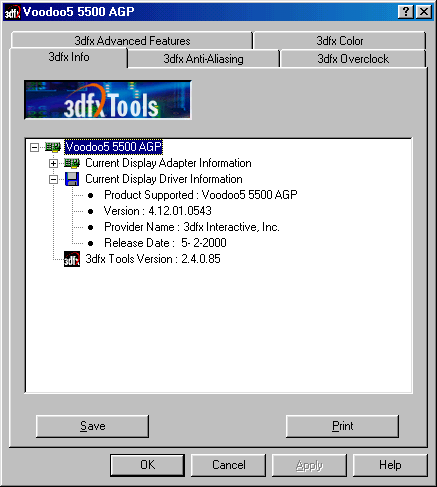
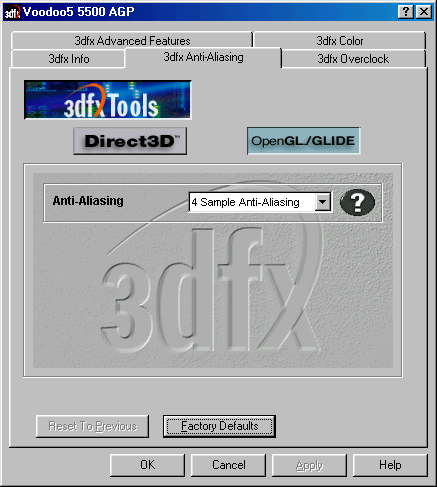
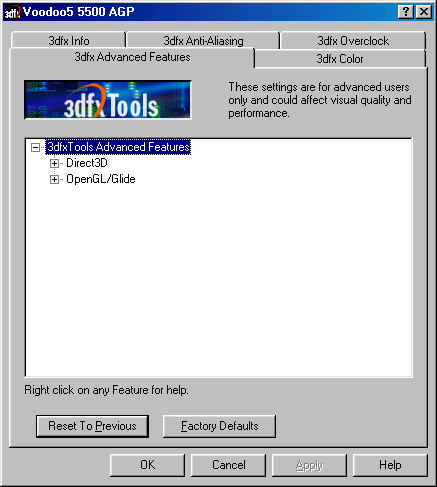
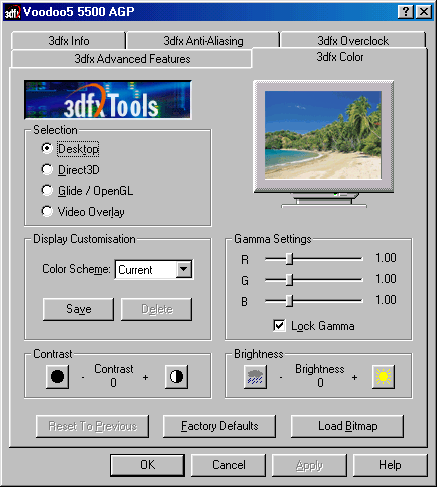
We ran the Voodoo5 5500 PCI through the same tests we ran the AGP version through, as shown in the test systems below. In addition, a lower end CPU, a Celeron 433, was used to show what kind of performance benefits using the Voodoo5 5500 PCI in an older system would give. This system setup is also show in the below table. The performance analysis given in the following sections is meant to serve mainly as a comparison between the speed of the Voodoo5 5500 PCI and AGP. For more detailed information on how the Voodoo5 5500 holds up against the competition on a more broad scale, take a look at our Voodoo5 5500 review.
|
Windows 98 SE Test System |
||||||
|
Hardware |
||||||
|
CPU(s) |
Intel Celeron 433
|
Intel Pentium III 550E |
AMD Athlon 750
|
|||
| Motherboard(s) |
IWill
WS133-N (i810)
|
AOpen AX6BC Pro Gold | AOpen AK72 | |||
| Memory |
128MB
PC100 Corsair SDRAM
|
128MB PC133 Corsair SDRAM |
128MB
PC133 Corsair SDRAM
|
|||
| Hard Drive |
IBM Deskstar DPTA-372050 20.5GB 7200 RPM Ultra ATA 66 |
|||||
| CDROM |
Phillips 48X |
|||||
| Video Card(s) |
3dfx
Voodoo5 5500 AGP 64MB ATI
Radeon 64MB DDR ATI
Rage Fury MAXX 64MB Matrox Millennium G400MAX 32MB (would not run on Athlon platform) NVIDIA
GeForce 2 MX 32MB SDR (default clock 175/166) S3 Diamond Viper II 32MB |
|||||
| Ethernet |
Linksys LNE100TX 100Mbit PCI Ethernet Adapter |
|||||
|
Software |
||||||
|
Operating System |
Windows 98 SE |
|||||
| Video Drivers |
|
|||||
|
Benchmarking Applications |
||||||
| Gaming |
GT
Interactive Unreal Tournament 4.04 AnandTech.dem |
|||||
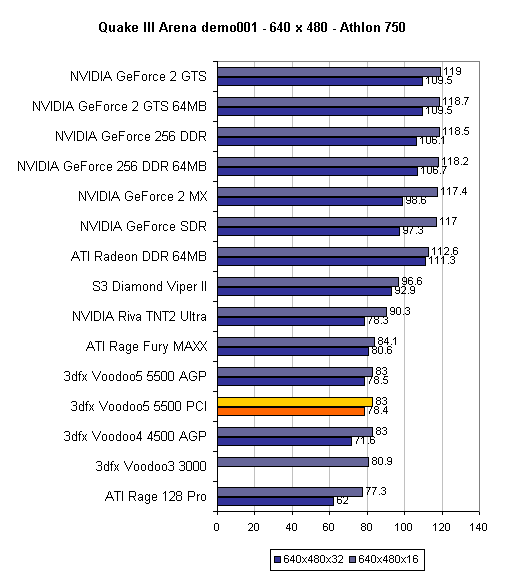
Instantly it is seen that the Voodoo5 5500 PCI is still a Voodoo5 5500 at heart. The differences in frame rate between the AGP version of the card and the PCI version of the card are not noticeable in normal game play in either 640x480x16 or 640x480x32. The faster speeds at which the AGP card travels at does not result in any performance gain, mainly due to the small amount of information that must travel to and from the card at this low resolution.
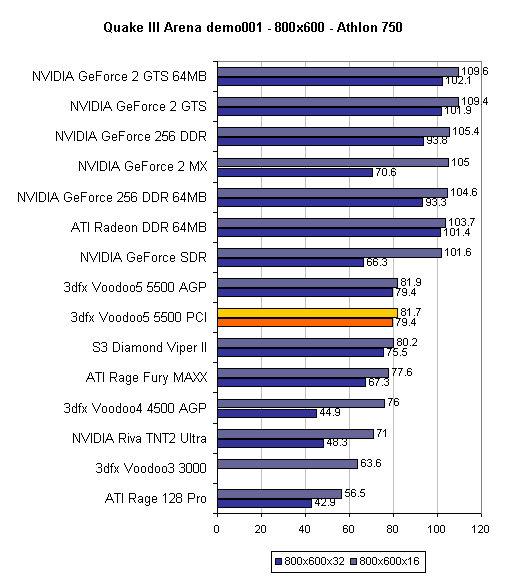
We find the story to be the same at 800x600, with the PCI card coming within a hair of the AGP card. The lack of performance difference seems to be based on the fact that the AGP card is not taking advantage of all the features of AGP, making the PCI card just as fast.
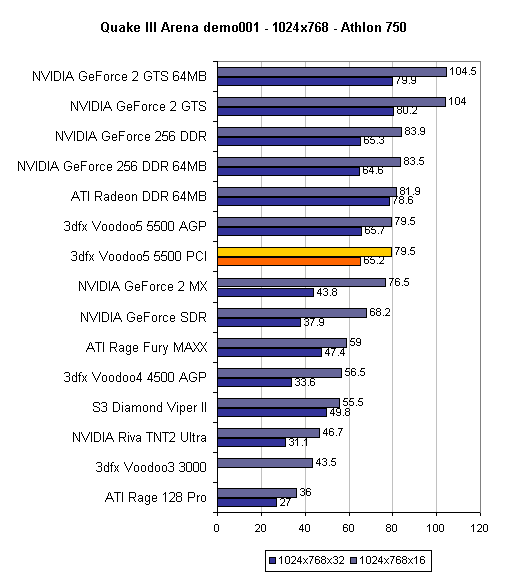
Once again, the PCI card matches performance of the AGP Voodoo5 5500, easily beating the other processors shown here that are offered in a PCI configuration.


Even just glancing at the above graphs, it becomes clear that the Voodoo5 5500 PCI is just as fast as the AGP version, proving for a high performing PCI video card. The largest frame rate difference between the two cards came at 1280x1024x32, where the PCI card lagged 2.4 FPS behind the AGP version. This difference is far from noticeable, especially at the 39.7 FPS that the card was already getting.
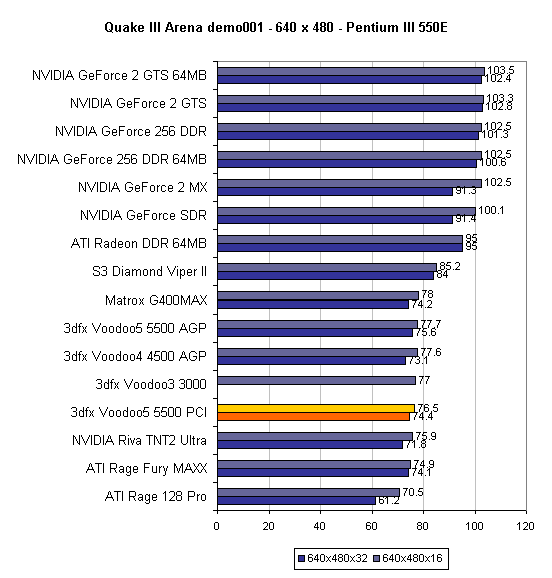
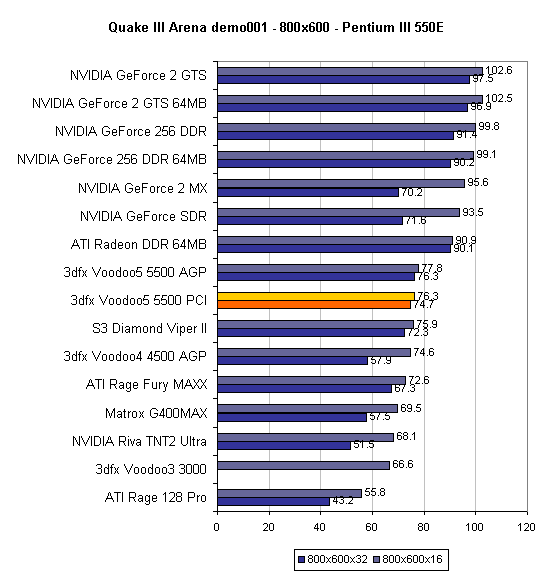
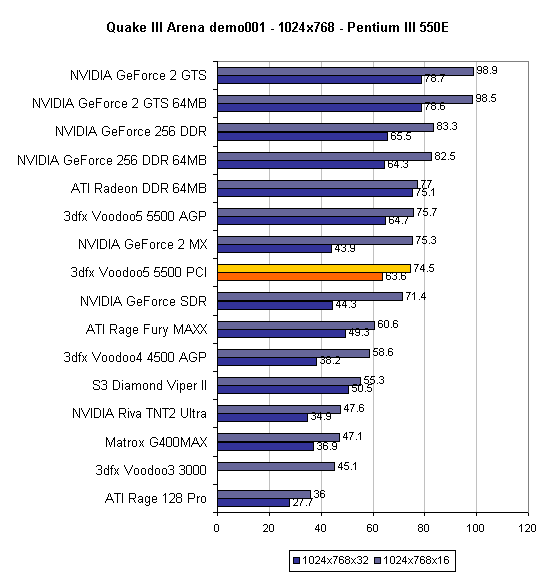
Our Pentium III 550E system, a system that may be typical of some i810 owners, provided for similar results to the Athlon 750 platform. Once again, we find that the PCI Voodoo5 5500 performs nearly identically to the AGP version. Apparently the extra 33 MHz that information is able to travel to and from the card in the AGP version does not provide for any real world performance boost. The two cards position on the graphs are pretty much interchangeable.
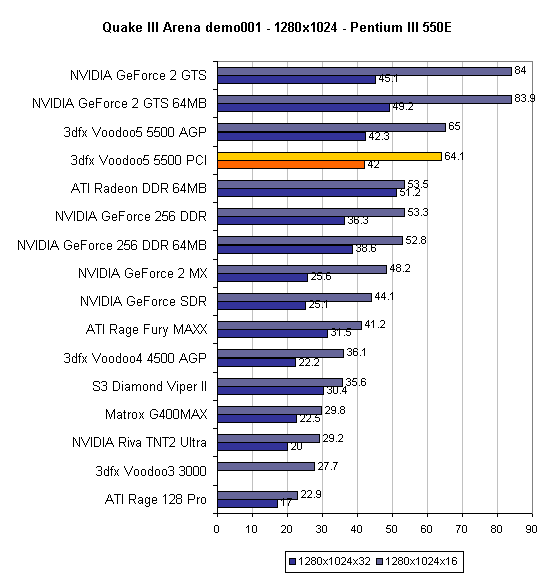
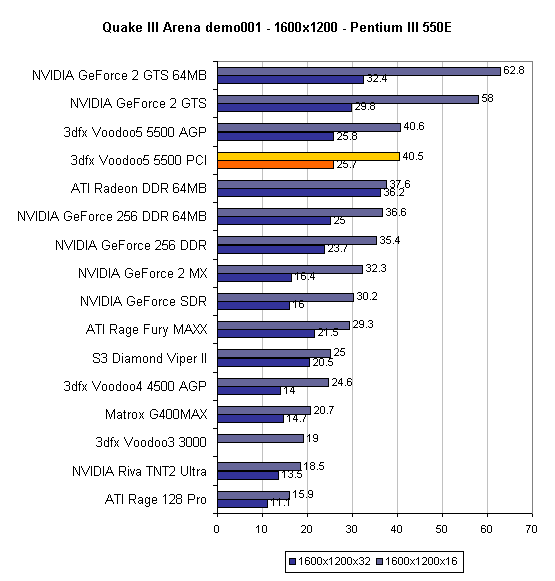
As found previously, the PCI Voodoo5 5500 performs the same as the AGP Voodoo5 5500.
Unreal Tournament - Athlon 750
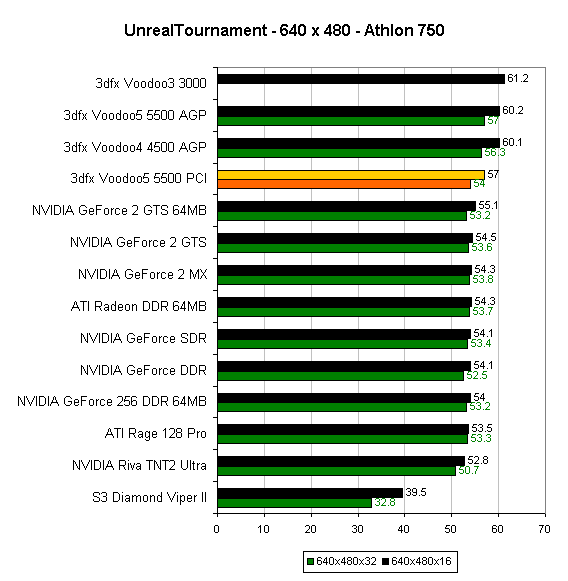
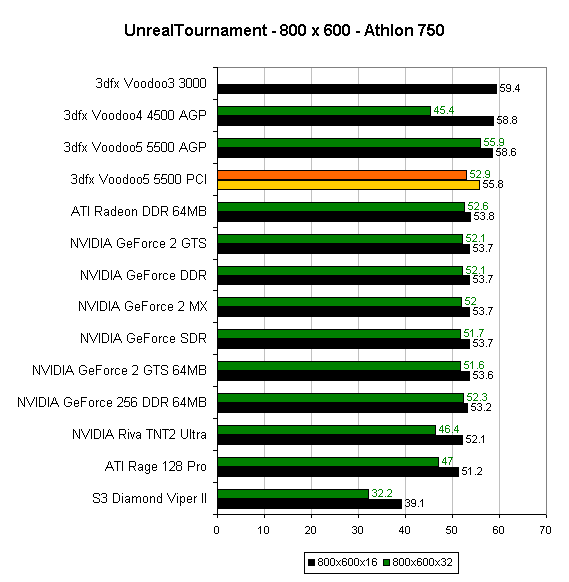
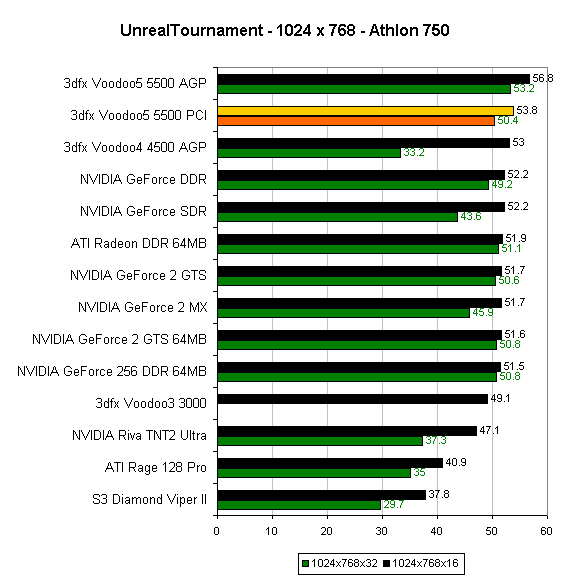
We find that in Unreal Tournament, a game which seems to heavily favor 3dfx products, the Voodoo5 5500 PCI performs just as fast as the AGP version, resulting in one fast PCI card.
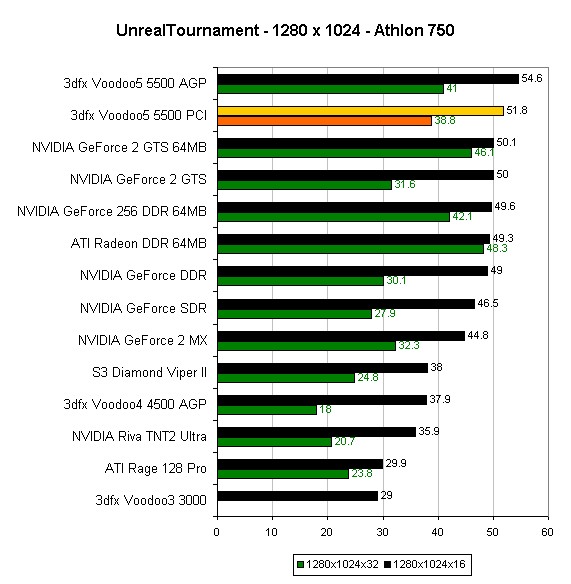
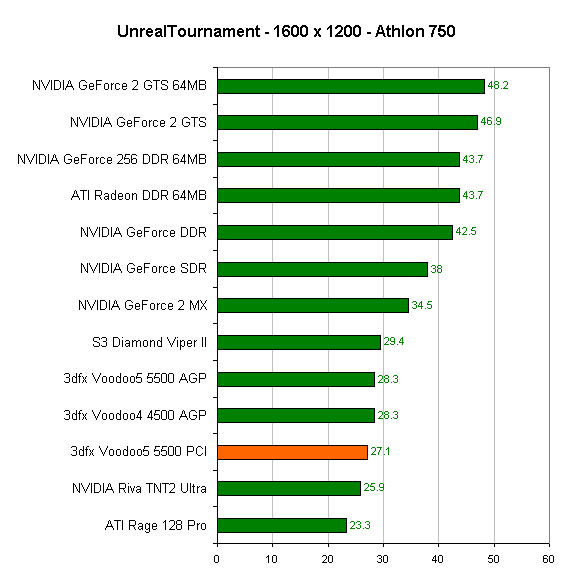
The results are really no different at higher resolutions, with the PCI card falling only 1.2 FPS behind the AGP card when at 1600x1200x16. The max difference comes at 1280x1024x32, with the PCI card performing 2.3 FPS slower than the AGP card, a difference that may be attributed to the slower bus speed of the PCI card. This difference, however, is not really noticeable.
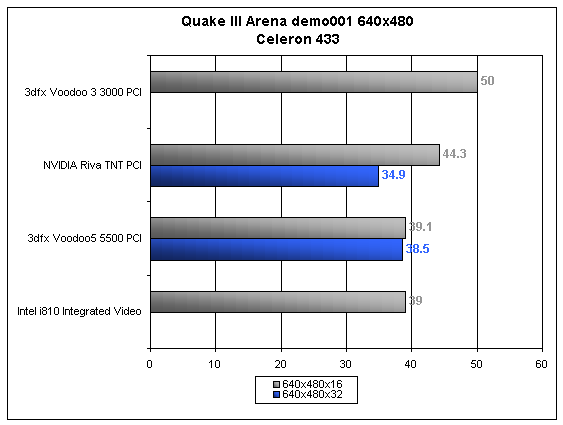
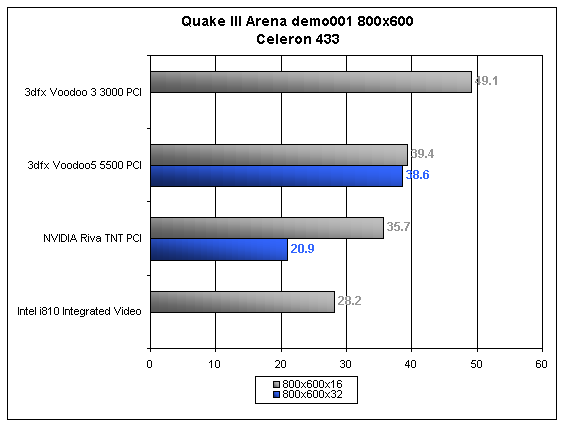
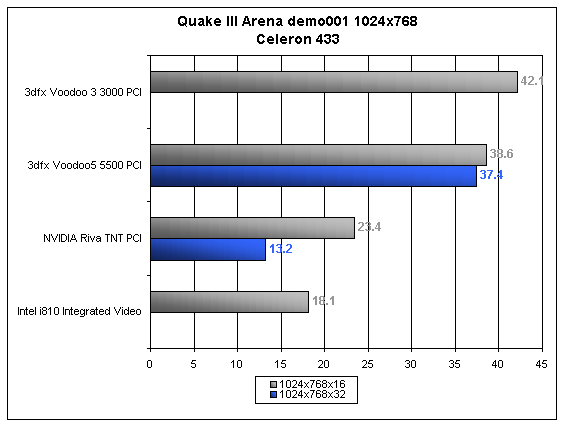
The Celeron 433 system was included in this review to show what the performance of the Voodoo5 5500 PCI is like on a typical lower-end system that my require a PCI video solution. Upon first glance, it seems that the Voodoo3 3000 is the fastest card in this type of system, and in fact at 16bit color it is. All the way through the range, up through 1024x768, the Voodoo3 3000 seems to be the best card for use in 16-bit color. Since the system is severely CPU limited when in Quake III, as shown by the almost nonexistent performance drop throughout the resolutions, the age of the Voodoo3 3000 works in its advantage. Better drivers seem to have offloaded some of the pressure that the CPU faces in intensive gaming situations, making the Voodoo3 3000 decrease the amount of CPU bottleneck experienced. In addition, the Voodoo3 3000 can only use 256x256 textures, while the other cards can use up to 2048x2048 textures. Although this fact decreases image quality, it does decrease the amount of work that the CPU must do.
If you are concerned with playing games in 32-bit color, the choice is clear: the Voodoo5 5500. If 32-bit color is not as important, it seems that the Voodoo3 3000 is the best card for the money when at lower resolutions in Quake III Arena.
Quake III Arena- Celeron 433 (cont)
 \
\
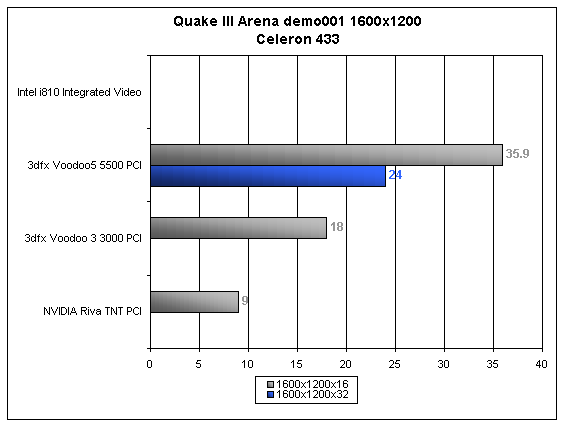
At higher resolutions of Quake III, the CPU becomes less of a bottleneck for older cards as the video card starts to become the limiting factor. Here we see that the Voodoo5 5500 takes top place in 16-bit color as well as 32-bit. With power to spare still, the speed of the card is not very much less at these resolutions than in lower resolutions due to the CPU acting as the bottleneck. At 1600x1200x32, it seems that the Voodoo5 5500 becomes the bottleneck, as the frame rate drops significantly.
Quake III Arena Quaver- Celeron 433

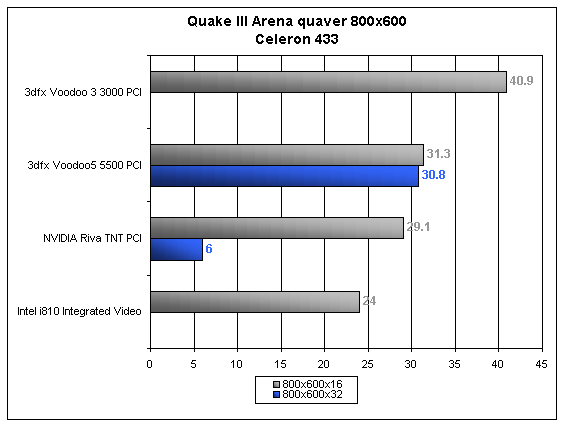
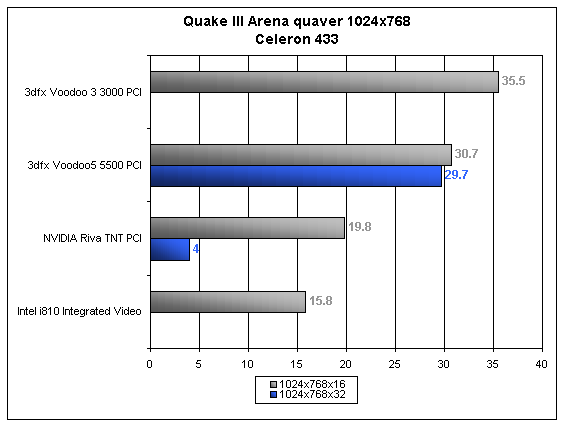
In Quaver, we see the lack of S3TC compression in all cards but the Voodoo5 5500 provide for quite a slow game. The cards end up texture swapping almost constantly to keep up with the huge textures that are present in the Quaver demo level. This is only really apparent, however, when in 32-bit color, making the Voodoo3 3000 still fastest in 16-bit color where texture sizes are small enough to fit in the on-card memory.
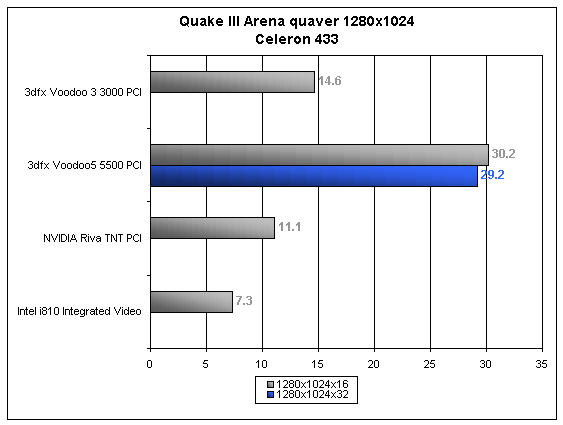
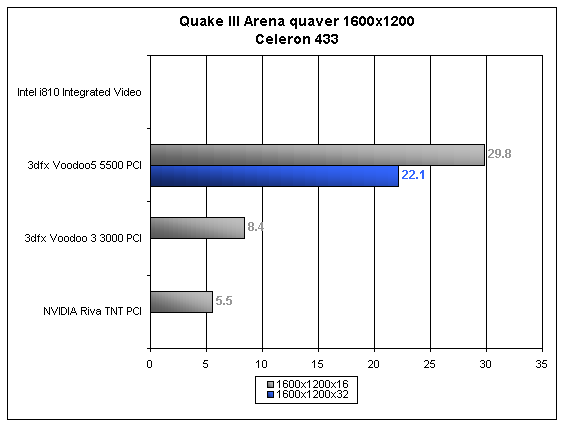
We see that the older cards are unable to complete Quaver at higher resolutions in 32-bit color. Enter the Voodoo5 5500, with its ability to not only do this, but do it rather fast for such a CPU limited system. Note the very low performance decrease when going from 1280x1024x16 to 1280x1024x32, a fact that is a result of the CPU bottleneck.
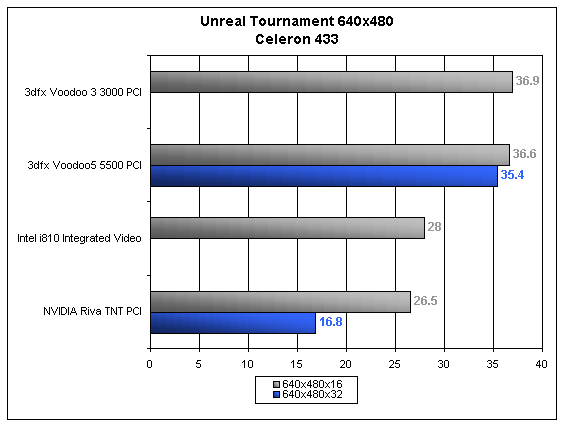
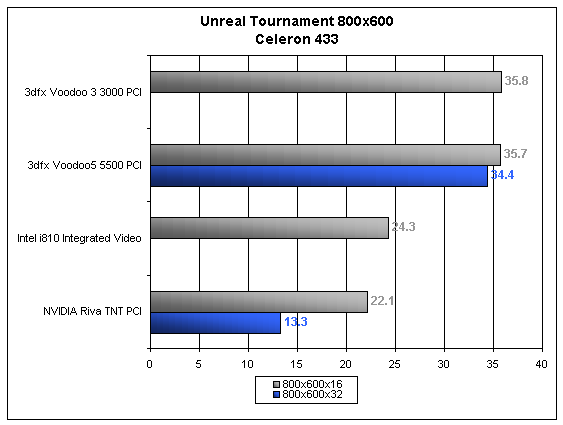
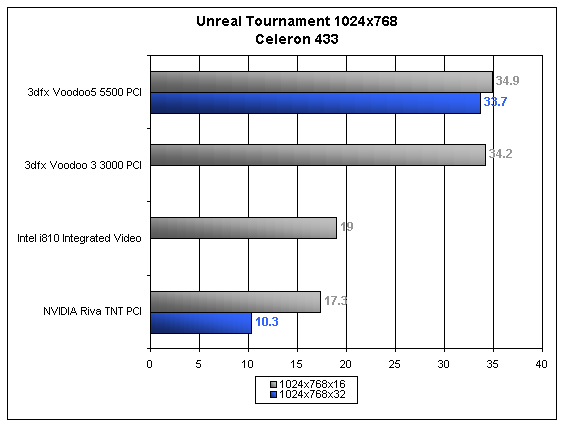
The Voodoo3 3000 does not remain king of 16-bit color on the older Celeron system for very long, with the Voodoo5 5500 beating it at 1024x768x16.
Unreal Tournament - Celeron 433 (cont)
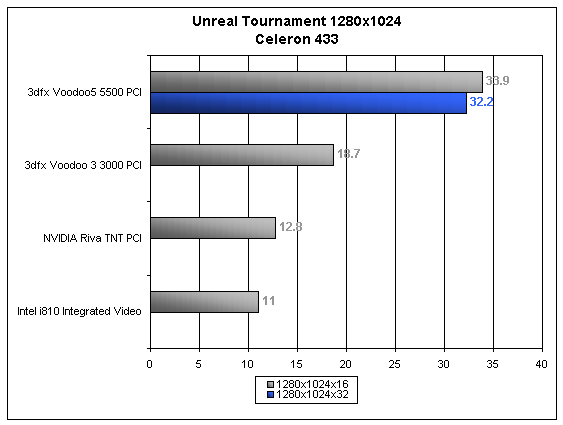

Pretty much self explanatory, with the Voodoo5 5500 being the fastest card of the bunch. A nice benefit of having a CPU limited system is that the Voodoo5 5500's frame rate at 1280x102x32 is not very much different from the frame rate at 640x480x16
We already know from both our Voodoo5 5500 review and our FSAA & Image Quality Comparison. how the Voodoo5 5500 will perform with FSAA enabled on higher end systems. For many users out there considering a PCI video card, the CPU in their system may not be as fast as some of the ones tested for previous FSAA tests. As we explained earlier, the CPU quickly becomes a limiting factor in many newer games with the Celeron 433 tested. This means that the video card is not being utilized to its full extent during game play, as the system is bottlenecked by the CPU. Essentially, this results in unused video card power, just waiting for you to harvest. The best way to do this in aged systems is to enable FSAA.
By enabling
FSAA, one forces the unused portion of the video card to do work, allowing the
video card to become a bottleneck along with the CPU. This results in almost
no speed loss when going from no FSAA to FSAA 2x in systems with
older CPUs, as the card is finally able to use all its might. If you are happy
with the framerate with your current video card setup, you will most likely
want to run the Voodoo5 5500 with FSAA enabled, maintaining the same frame rate
as before but increasing the image quality a noticeable amount. The below graph ion With the arrival
of t
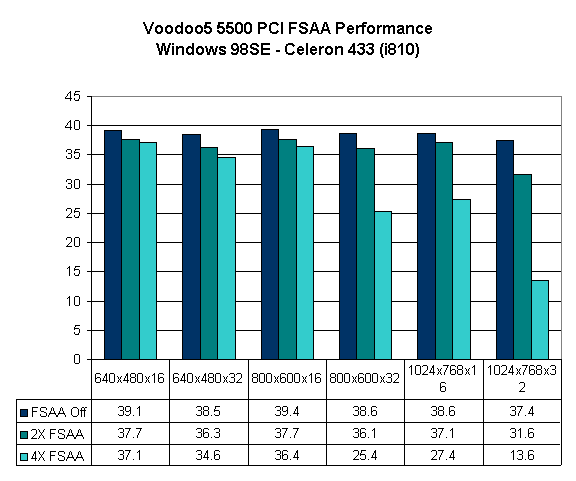
Notice how the card's performance decreases only slightly when FSAA is enabled.
With the arrival of the PCI Voodoo5 5500, new life can be brought to aging systems. If you are running on a higher end CPU, such as a Pentium III 550E or above, and are limited to a PCI video card, the Voodoo5 5500 is a blessing. No longer must you suffer through slow games due to the lack of a good PCI video card.
In older systems, with lower-end CPUs, the Voodoo5 5500 can only do so much before it is limited by the slow speed of the CPU. As our Celeron 433 tests showed, the card is not strikingly faster than the old (and inexpensive) Voodoo3 3000. With the CPU acting as such a bottleneck, it seems like the best idea would to be to upgrade the CPU now and get a faster video card later, when the system can actually take advantage of it.
One nice aspect of running the Voodoo5 5500 in a lower end system is the fact that enabling FSAA will result in almost no performance loss. Since the video card is not able to use all its power with FSAA off in an older system due to a CPU limitation, enabling FSAA is really the only way to get the full power out of the Voodoo5 5500 PCI in an older system. The frame rate may be as low as before you upgraded to the $300 card, but the image quality will be much better.
The Voodoo5 5500 is a blessing for many users out there with higher end CPUs on an i810 motherboard. For others with lower end processors, the Voodoo5 5500 really only makes sense if FSAA is desired. Otherwise, stick with your current video card (or perhaps upgrade to a Voodoo3 3000) and look for a CPU upgrade first. With a fast PCI video card option finally out. 3dfx will win a place in even more systems.







